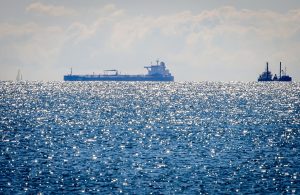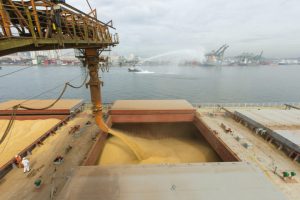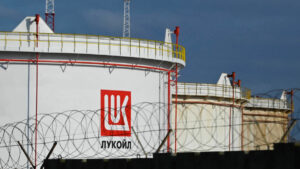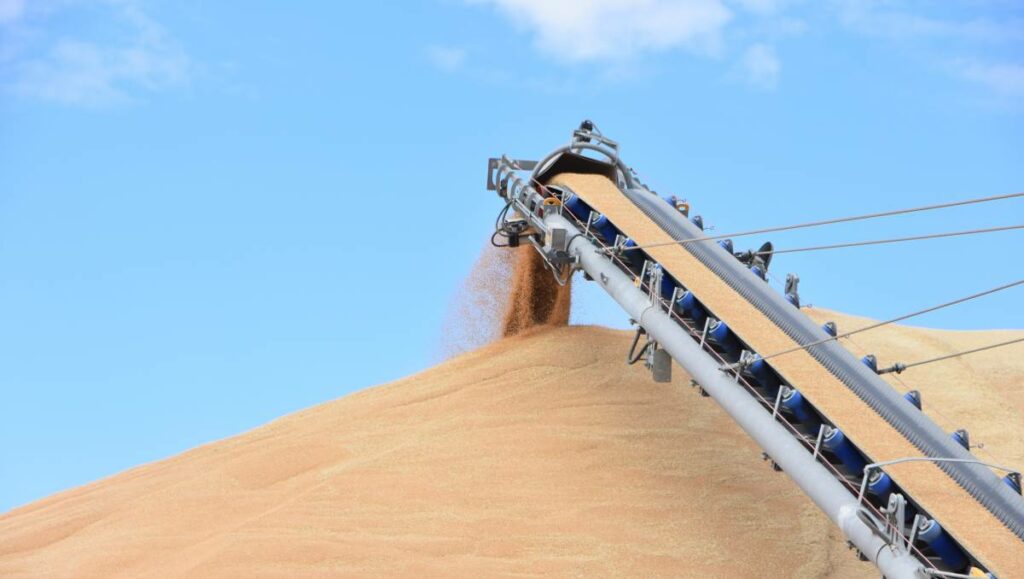A small step or a victory: will the opening of the of the Bystre estuary affect grain exports?

On Saturday, July 9, it became known that the Bystre Estuary was open again. Piloting along the estuary became available again thanks to the liberation of Zmiinyi Island and ensuring the safety of the coastal section of the water area in this part of the Black Sea. USM tells what effect the opening of the Bystre Estuary will have on Ukrainian exports and what are market participants afraid of.
“Navigation along the Danube-Black Sea channel has been restored. Taking into account the liberation of Zmiinyi Island from russian troops and the accumulation of a large number of ships waiting to pass through the Sulina Channel, it is possible to use the Bystre Estuary for the entry / exit of ships carrying agricultural products,” the Ukrainian Sea Ports Authority reported on July 9.
First, two barge-towing caravans were driven through the channel (1 tug and 1 barge in each caravan) to check the throughput of the estuary. Then they determined:
the movement of vessels along the maritime approach channel and the Bystre estuary is possible only during daylight hours. The maximum safe draft of vessels is 3.90 m in sea water.
For four days of work, 16 vessels passed through the channel – all of them immediately queued up for loading grain in Ukrainian ports on the Danube.
To understand why the opening of the Bystre Estuary during the war is so important for Ukrainian exports, it is worth turning to history.
The question of a deep-water shipping channel was first voiced in the middle of the 19th century. For small vessels, all branches of the vast Danube Delta were available. Currently, there are several options for the Danube-Black Sea navigable fairways, with their own advantages and disadvantages. One of these options is the Bystrу estuary.
Now the estuary is an alternative to the Romanian Sulina Channel. In some ways, Bystre looks even more powerful than the “Romanian brother”. Before the full-scale invasion of russian federation, it was possible to pass along the Bystre estuary at any time of the day in good weather, and two-way piloting was also practiced.
But the Ukrainian estuary clearly loses to the Sulina Channell in draft – the current draft in Bystre is 3.9 meters, or even lower. Depending on depths and weather conditions, pilots now insist on a maximum of 3.7 meters. Therefore, some ships will be able to approach Ukrainian ports on the Danube empty, but leave loaded only through the Sulina Channel.
Why Bystre will help Ukrainian exports?
Since February 24, all Ukrainian ports, except for those on the Danube, have been closed due to the war. An alternative to domestic maritime exports has become a way to deliver goods by land transport to Romania and Moldova, and from there already send goods by ship.
But this did not completely solve the problem. First of all, due to the “stretched” logistics, it became unrealistic to export pre-war volumes from Ukraine. Secondly, land transport will not be able to replace the volume of exports through ports. Therefore, the Ukrainian government and businessmen were actively looking for a water alternative to large ports. Work began in the ports on the Danube.
So how will the opening of the Bystre Estuary help exporters? As of July 11, more than 130 ships were waiting at the entrance to the Romanian Sulina Channel, according to USM. The congestion is connected with the activation of navigation in Romanian waters after the start of the full-scale aggression of russian federation in Ukraine.
In addition, navigation in the area is complicated by the fact that the Sulina Channel is a one-way channel. Therefore, ships can expect to pass for weeks. Opening the Bystre estuary will help to unload this plug – again, with a proviso to draft and depth. However, it can be expected that Bystre will still “take over significant percentage of ships “.
The fact that the opening of Bystre is an important step for Ukrainian exports is also confirmed by Deputy Minister of Infrastructure of Ukraine Yurii Vaskov:
“Over the past 4 days, 16 ships have already passed through the Bystre estuary. We plan to keep this pace. The restoration of navigation through this channel is an important step, which will also make it possible to unload the roadstead of the Sulina Channel and speed up the export of grain.
Unfortunately, its capacity and the organization of work on this channel make it possible to receive only 4 ships, while it is necessary to receive at least 8 ships per day”.
How much will the “maritime” export of Ukrainian grain increase? Vaskov believes that, thanks to Bystre, Ukraine will be able to increase its monthly grain exports by 500,000 tons.
Also, as USM managed to find out, in the near future Ukraine plans to deepen the bottom and modernize the estuary, which will allow large vessels to be launched. Bystre really has potential: on November 11, 2010, an absolute record for the number of ships was recorded on this section. Then, during the day, the pilots led 19 ships along the estuary. However, the Ministry of Infrastructure of Ukraine demonstrates restrained optimism.
“Even if the logistics through the Danube ports is optimized, their throughput capacity will still not be enough to fully replace the seaports. In June, the existing logistics routes managed to export approximately 2.5 million tons of products, while the monthly need for the export of such products is 8 million tons,” the Ministry of Infrastructure believes. Overall, the Ministry has announced an ambitious plan to almost double the transshipment of cargo in the Danube ports, to 25 million tons per year.
The development of the Danube port cluster is already one of the priorities in the work of the Ukrainian government. Recently, the Minister of Infrastructure of Ukraine Oleksandr Kubrakov announced that businesses that invests in the development of Danube logistics will be provided with preferential credit instruments.
The Ukrainian Seaport Authority did not stand aside either. The agency calculated that the liberation of Zmiinyi Island and the deblockade of the Bystre Estuary would save the business at least $500,000 per day.
“An additional window will speed up the pace of grain-carrying ships to the Danube ports. At the same time, we are working with our Romanian colleagues to ensure that logistics processes are as fast and efficient as possible,” said Aleksey Vostrikov, head of the USPA.
In addition to calculations, USPA also moved to actions. In particular, it has created a transparent mechanism for weekly planning of shipping to the Danube ports through Sulina – the final plan will be coordinated by port operators.
In addition to the weekly plan, now the USPA website will publish daily information with an up-to-date list of ships in the Sulina roadstead; a weekly report on the ships conducted through the channel and a report on the development of the weekly plan by the Romanian colleagues.
Topical issues
The fact that the Bystre Estuary has again become available for shipping is an excellent alternative to the Sulina Channel. However, some market participants are confident that there are still many unresolved issues ahead.
Maritime Logistic director Anton Shapran told USM that it is now difficult to predict how the opening of the estuary will affect freight rates and waiting times.
“Yes, escorting vessels to Ukrainian ports on the Danube will become faster, but there is also loading. The number of port facilities did not increase. Now we need to live for a certain period and see, what effect those who will be the first to follow the alternative route and get to the berths will get, ”says Shapran.
In addition, the director of Maritime Logistic believes that the opening of the estuary creates a new dilemma for the charterer:
“For example, there is a charterer. He has a ship in the Sulina roadstead for a week. Accordingly, there are losses: the longer the vessel stands idle, the more demurrage is charged. And now this charterer finds another ship that can immediately enter the port through the Bystre estuary. And then a dilemma is born – who to put first? If the charterer chooses the one, which immediately passes through Bystre, then the owner of the vessel, which is in the Sulina, may have questions. So now there will be a lot of personalized approach to work in this region.”
Anton Shapran also shared the idea that the freight price may not change:
“It is difficult to assess changes in the freight rate. Perhaps the freight will not decrease due to the fact that the shipowner is now “on horseback”. There are many charterers, they need to export cargo as soon as possible, and shipowners have a limited pool. Not everyone is ready to stand idle in the Sulina roadstead for weeks and leave other cargo flows for this. Accordingly, charterers will still have to compete for available vessels. There are also shipowners’ concerns about the safety of the passage. Insurance companies will not cover the military risks of passage through Bystre, because the Black Sea, north of the entrance to Sulina, is a war risk zone. So all the risks turn out to fall only on the shipowner.”
Other market participants share these concerns. Now the exit of loaded ships from Ukrainian ports is possible only through Sulina. And there is a high probability that the Romanian side may increase the fee for one-way piloting.
What is the result? Opinions vary. On the one hand, the empty berths of Ukrainian ports on the Danube will be filled faster. Prior to the opening of the estuary the piloting was carried out through the one-way Sulina. Only this aspect increased the waiting time by a couple of days. On the other hand, businessmen are afraid of corruption schemes that may be born as a result of the opening of Bystre.
In addition, piloting through the estuary is not the final solution to the problem. The effect of the deblockade of seaports will be much stronger. This is understood even in the UN. Thus, UN humanitarian aid coordinator Martin Griffiths said that the opening of Bystre (unlike the deblockade of Ukrainian seaports) would not prevent world hunger. The Ukrainian Minister of Infrastructure Oleksandr Kubrakov shares the same position. The official notes that the Danube Delta can become a “lifeline” for countries that are in danger of starvation, but the throughput is still not enough to fully replace the seaports.
As you can see, the opening of the Bystre Estuary is just another step towards solving the problem, but not the solution itself. The further development of the situation depends entirely on the ceasefire and on the victory of Ukraine over the invaders. Any other options are just temporary and targeted attempts to “stick it with blue tape”. Only the expulsion of the enemy from the Ukrainian land will be able to give the ports the opportunity to fully and safely operate, returning money, goods and a quality standard of living to the country for each of us.





